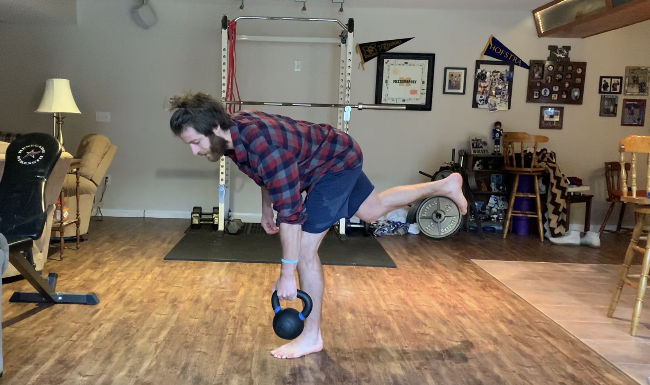The single-leg Romanian deadlift (RDL) is one of the most popular unilateral lower body exercises for training the posterior chain and for good reason. The single-leg RDL targets multiple muscle groups, works and improves imbalances, and is great for building coordination and body awareness.
While the single-leg RDL is a great exercise that everyone should add into their training program, it’s not an exercise that everyone is ready to add. The single-leg RDL is as much of a skill as it is an exercise and it needs ample attention for correct execution.
In this article, we’re going to discuss three progressions for nailing the single-leg RDL. If you’re brand new to this exercise, then start from progression one and ease into each one to effectively learn this movement.
Related: Check out our in-depth Romanian Deadlift (RDL) guide!
1. Own the Concentric
The first step to owning the single-leg RDL is mastering the concentric and eccentric movement patterns, respectively. Generally, the concentric (lifting/standing) portion of this exercise is the easier movement pattern to conquer so we’ll start our journey here.
Mastering the concentric first is great because it helps isolate the contraction feeling that comes along with this exercise. At times, single-leg RDLs can look more like balancing and shifting weight acts that are nearly void of a quality contractions than anything else — this is what we want to avoid.
So, starting with the understanding of what a quality contraction should feel and look like will be a good place to start when roadmapping this exercise when training alone. Basically, when reps are off or poorly executed, you’ll have a better understanding of knowing that feeling so you can self correct.

Do This
- Grab a single dumbbell or kettlebell and place it front of the body just off the pinky toe on the grounded foot side. My advice, opt for a kettlebell if you can to reduce some range of motion.
- If achieving a position where the torso is relatively parallel to the ground seems impossible, then place the dumbbell or kettlebells on blocks (as shown above) or 2-3 stacked 45 lb plates.
- Assume a single-leg RDL position where the back leg is in the air (it can be bent if needs), the hips are hinged, and there’s a soft bend in the knee of the grounded leg with the foot gripping the floor.
- Once you’ve done this, reach for the implement and light brace. After grip is secured, lift and stand up with the weight.
- At the top, bring the other foot back down, place them implement on the ground and repeat this process only actively working through the concentric movement pattern.
The Rep Scheme: Perform three sets for 6-8 reps on each leg for 1-2 weeks before moving to progression two.
2. Master the Eccentric
When things go wrong in the single-leg RDL they’re generally in the eccentric (lowering) portion of the movement. This is when you see balance go awry, hips hike up, and implements float away from the body.
The eccentric movement pattern is fundamental to nail in this exercise because the ability to unilaterally load the hamstrings will have a ton of carry to strength sports, traditional sports, and day-to-day activities.
Plus, it’s one of the main reasons for performing this exercise, so if it’s not owned, then what’s the point?

Do This
- Starting in a standing position with a single dumbbell or kettlebell on the planted leg’s side and the offset leg slightly bent upwards behind the body (think 20-30 degree knee bend), start to initiate the lowering portion of the movement.
- Pay attention to the hips and try to keep the open hip shut down and parallel with the other hip to avoid compensating. Keep the implement tight to the body and tracking in a line.
- Once you’ve hit a range of motion where the lumbar starts to flex or the hamstring limits anymore movement (everyone’s will be different), bring the lifted leg back to the ground, then stand up as normal. Remember, only the lowering portion is being performed in this progression.
The Rep Scheme: Perform three sets for 5-6 reps with a 3-4 second lowering tempo on each leg for 1-2 weeks twice a week before moving to progression three.
3. Piece Them Together
Now that the concentric and eccentric movement patterns have been conquered it’s time to piece them together. This can be the hardest part of the exercise because natural discrepancies in how we move on a day-to-day basis can be present, so understanding when to shift gears during a complex movement like this is key for strong, consistent execution.
This is also when knowing your body comes into play. For example, have a tight right hip one day? Ease into the range of motion more slowly, or use what you feel as a sign to spend a little more time prepping that side for loading.
When in doubt with this exercise, there’s no shame in scaling back the weight, range of motion, or progression. Some level of quality contraction and loading is better than simply going through the motions.
https://www.instagram.com/p/B_OGIzRAuR0/
Do This
- Assume your normal single-leg RDL stance with a single dumbbell or kettlebell on the strong side foot (planted leg).
- Lower with a 3-second eccentric tempo and either:
- Perform the concentric portion as normal if everything feels great.
- Stack plates or have box ready to set the weight on before into the concentric portion. This is usually a good option for beginners who are struggling with the transition phase.
The Rep Scheme: Perform 3-4 sets with 6-8 reps on each side, or program them as a normal accessory!
Wrapping Up
The single-leg RDL is a fantastic exercise to accomplish, and it’s a movement that requires ample attention for proper execution. Simply moving through the motions with this exercise isn’t accomplishing much, so spending time on nailing the fundamentals is key for longevity and success.